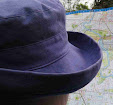 |
| Female Relatives Badge, WW1 |
 |
| Female Relatives Badge, WW2 |
I have known for a while that the National Archives of Australia held the Registers for these badges, but only tonight have I had another look for them and found them digitised, which is a huge plus. Unfortunately it will be a bit hit and miss as to whether you are likely to locate the recipient of a badge by the number on the back, in the sense that the coverage of these registers in this collection is incomplete.
If you look under Series number
MT1384/2 Registers of Issued Medals and Badges 1939/45 War - 1914/18 War and click on "Items in this Series on Record Search" you will find a long list of records, not all of which are Registers of Female Relatives Badges. It appears that the majority of available registers are from the WW2 period, with fewer available for WW1. States have separate registers, and it was my impression that there were fewer registers for Victoria than other states, but that might be my natural bias.
I could not locate an appropriate register for the WW1 badge at the top, which was among my mother's things. This is frustrating because I don't know any relative whom it might have represented. The only close relative to my mother who served was her uncle Jim, but he was in the Royal Navy, and the Australian Defence Department would not have handed out badges men who did not serve in the Australian Forces. In addition, the Naval version has an anchor in the centre, where AIF is shown in this one. Unless some more registers come to light (could there be some in another series?) it will remain a mystery for now.
I
was able to find a register entry for the WW2 badge using the registered number on the back. I bought this badge on eBay many years ago, so it was not issued to our family, but I had the thought that as none came to light amongst my paternal grandmother's effects, I would like one to recognise HER sacrifice. There are stories of her distress when my father was called into service with the CMF when he was 18, and sent to New Britain with the AIF when he was 19 or 20. It occurred to me only today that perhaps she never applied for a badge. (You had to fill in a form to get one). She was Catholic, which may have influenced her thinking on patriotic display. She was a young woman during WW1 when Archbishop Mannix spoke out against conscription.
I had a look at Ancestry to see if I could see the original recipient's family, but it is a little too recent for anything to appear. I will bide my time and check back from time to time.
The Registers record the name and address of the applicant, and the relationship to the member. It also gives the name, rank and unit (I found the VX number rather than a unit), the number of the application form, and a few other details, not necessarily the same as the column heading would suggest.
















